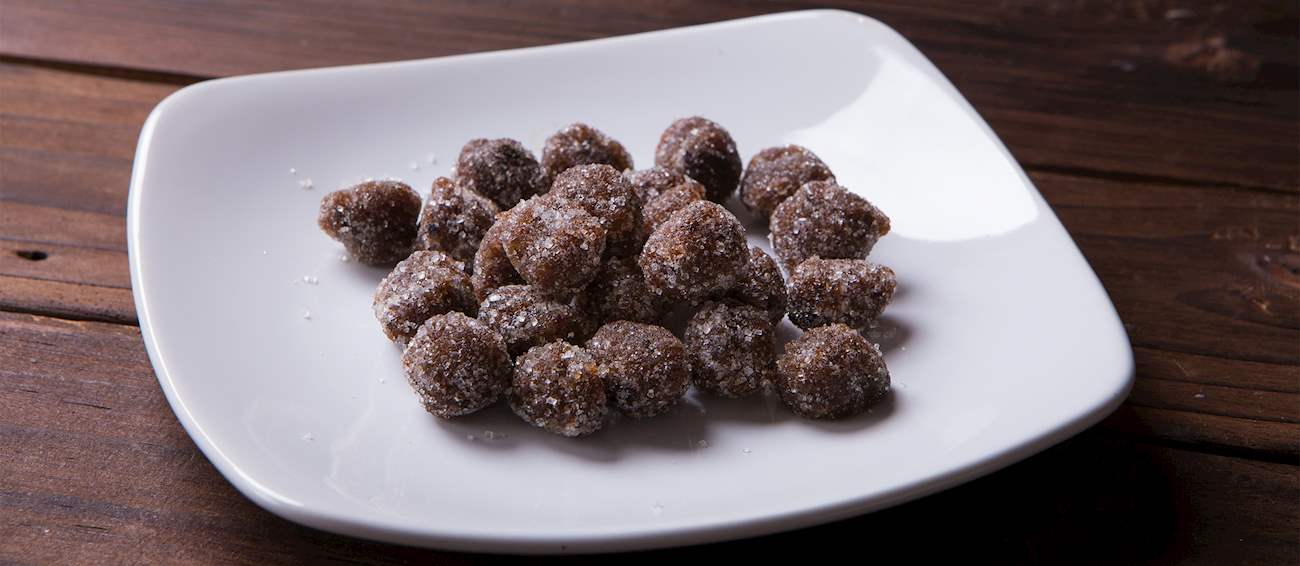Sweet potato pudding is a favorite Sunday dessert throughout Jamaica, consisting of sweet potatoes, flour, coconut milk, dried fruits, and flavorings such as vanilla, nutmeg, sugar, and salt. Although it can be baked in an oven, some Jamaicans still prepare it on a coal pot, where the charcoal is placed under the bottom and on top of the baking pan.
It is recommended to pair sweet potato pudding with a glass of milk.
MAIN INGREDIENTS
Tamarind balls are a Jamaican specialty made with tamarind's sticky flesh, water, and brown sugar. The concoction is rolled into round balls that have a unique, sweet and sour flavor. There is also a spicy Guyanese version of tamarind balls with hot peppers and garlic added to the combination, and an alcoholic version with added rum.
The balls are usually rolled in sugar one more time to finish them off, and they are then consumed or stored in airtight containers for later use.
An integral part of Caribbean cuisine in festive times, especially around Christmas, black fruit cake is a unique dessert filled with nuts, dried fruits, warm spices, and burnt sugar syrup - giving it a rich and bitter chocolate flavor and a typical deep black color.
Although the cake has numerous variations regarding the ingredients, rum is always mandatory. Black fruit cake has roots throughout the Caribbean, dating back to the 17th century when English settlers brought over their tradition of the English pudding, which was modified by the slaves and their descendants into a decadent rum cake over the years.
Gizzada is a flavorful Jamaican dessert consisting of a pastry shell filled with a sweet, yet slightly spicy coconut filling. It is characterized by its pinched crust, giving the dessert its other name: pinch-me-round. Although gizzada is very popular throughout Jamaica, it is believed that this sweet treat has Portuguese or Jewish origins.
Peanut drops are popular Jamaican snacks made by boiling roasted peanuts and minced ginger in water with brown sugar. The peanuts are boiled until the water evaporates and the sugar becomes sticky like caramel. Peanut drops are left to cool and harden before they are ready to be served and consumed.
These traditional treats are enjoyed both by young and old throughout the island.
Bulla cake has a round and flat shape, and it is made with flour, molasses, and baking powder. It can be either light- or dark-colored and is often spiced with ginger or nutmeg. The cake first appeared in the 19th century and from the 1980s it’s being produced mostly by large bakeries in Jamaica.
This popular treat for schoolchildren is usually eaten with butter, avocado, and cheese.
Hummingbird cake is a Jamaican dessert that is typically made with flour, vegetable oil, bananas, pineapple, pecans, eggs, vanilla, sugar, salt, cinnamon, and leavening agents. It is usually served with cream cheese frosting. Often thought to have been invented in the late 1960s, the cake was originally called doctor bird cake, referring to a nickname for a Jamaican hummingbird variety known as red-billed streamertail.
Many people believe that the cake was named after the bird because the yellow streaks of banana are reminiscent of the bird’s plumage, while others say it is because the cake is sweet enough to attract hummingbirds. In 1968, the Jamaican tourist board wanted to attract tourists by sending press kits to the United States.
Coconut drops are traditional Jamaican treats made by boiling tiny pieces of coconut in a combination of brown sugar and spices such as vanilla, salt, and powdered ginger. The lumps produced by the mixture are left to cool on a flat surface to form rough cakes with an unusual shape and visual appearance.
These treats are one of the first snacks that were sold at the school gates in Jamaica.
TasteAtlas food rankings are based on the ratings of the TasteAtlas audience, with a series of mechanisms that recognize real users and that ignore bot, nationalist or local patriotic ratings, and give additional value to the ratings of users that the system recognizes as knowledgeable. TasteAtlas Rankings should not be seen as the final global conclusion about food. Their purpose is to promote excellent local foods, instill pride in traditional dishes, and arouse curiosity about dishes you haven’t tried.





